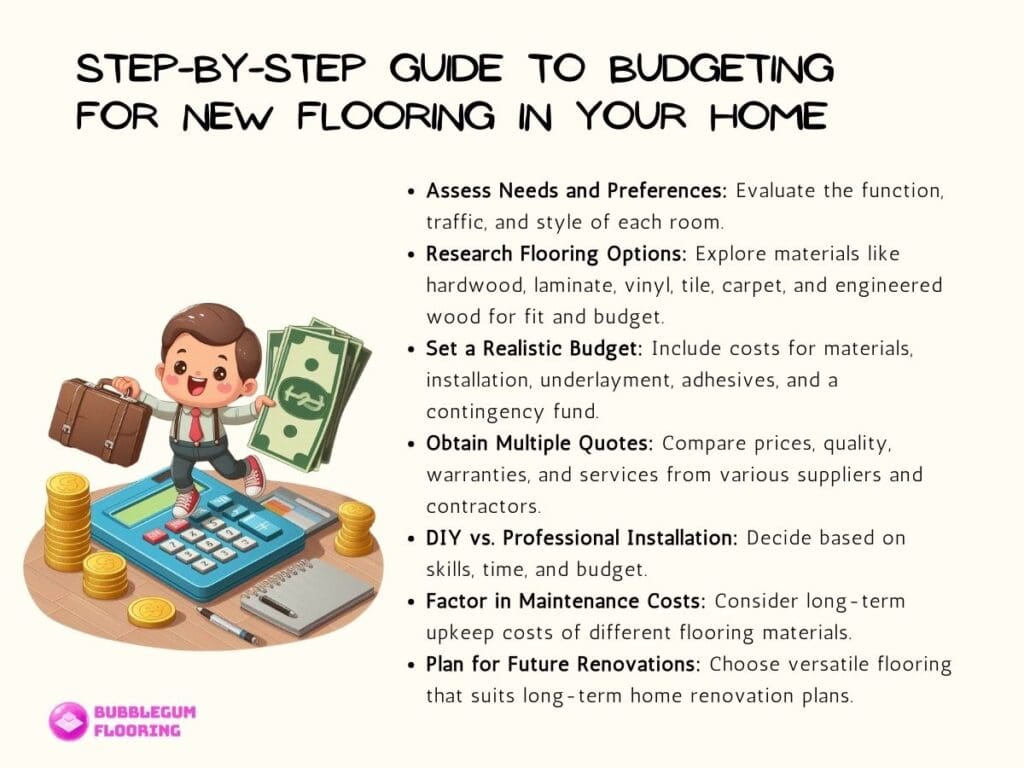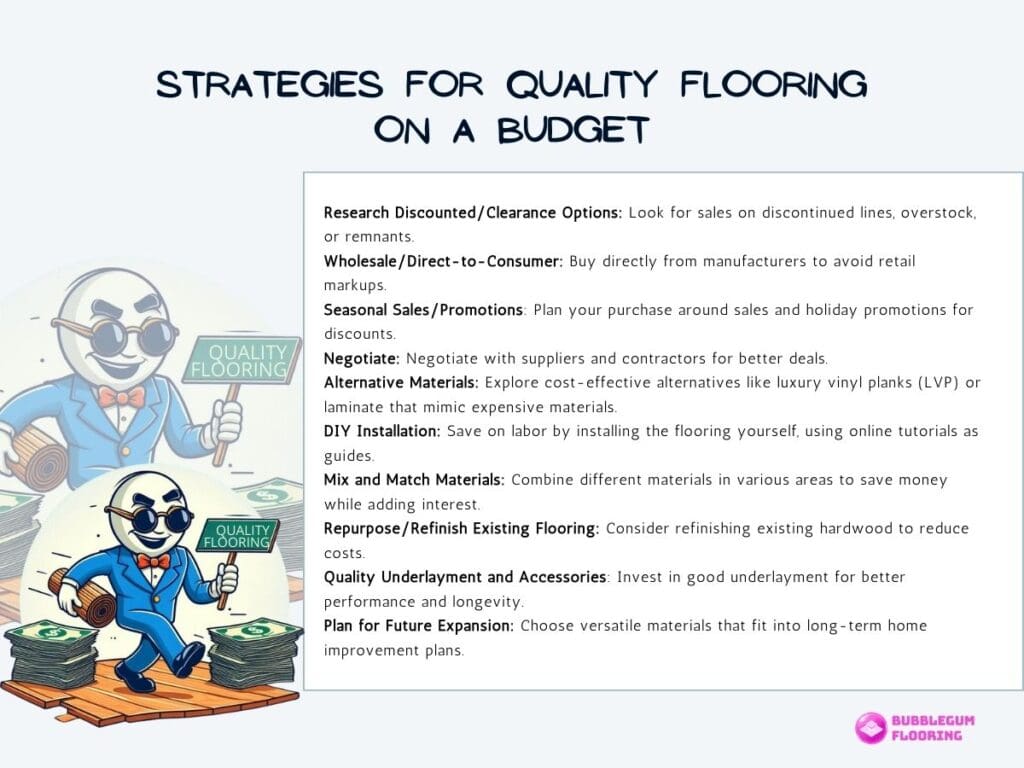Revamping the flooring in your home can breathe new life into your living spaces, enhancing both aesthetics and functionality. However, embarking on such a project requires careful planning, especially when it comes to budgeting.
From material costs to installation expenses, there are several factors to consider to ensure that your flooring upgrade aligns with your financial resources. This guide aims to provide you with a step-by-step approach to budget for new flooring in your home effectively.
Step-By-Step Guide to Budgeting for New Flooring in Your Home
When it comes to home renovations, few projects can transform the look and feel of a space as dramatically as installing new flooring. Whether you’re looking to upgrade worn-out carpets, replace outdated tiles, or refresh your hardwood floors, investing in new flooring can breathe new life into your home.
Here’s a comprehensive guide to help you navigate the budgeting process for new flooring.

1. Assess Your Needs and Preferences
Begin by evaluating your requirements and preferences for each room where you plan to install new flooring. Consider factors such as the function of the space, the amount of foot traffic it receives, and your personal style preferences. Different rooms may have different flooring needs, so take these into account when planning your budget.
2. Research Flooring Options
With a clear understanding of your needs, research the various types of flooring materials available. Common options include hardwood, laminate, vinyl, tile, carpet, and engineered wood. Each material has its own characteristics, benefits, and price points. Explore different styles, colors, and finishes to find the best fit for your home and budget.
3. Set a Realistic Budget
Based on your research and assessment, establish a realistic budget for your flooring project. Consider not only the cost of materials but also factors such as installation, underlayment, adhesives, and any additional supplies or services required. It’s essential to set aside a contingency fund for unexpected expenses that may arise during the renovation process.
4. Obtain Quotes from Multiple Suppliers and Contractors
To get a comprehensive view of the costs involved, gather quotes from multiple suppliers and contractors. Compare prices, product quality, warranties, and installation services offered by different vendors. Keep in mind that the lowest price may not always guarantee the best value, so consider the overall quality and reputation of the suppliers and contractors.
5. Decide Between DIY and Professional Installation
Consider whether you’ll tackle the installation yourself or hire professional contractors. While DIY installation can save money on labor costs, it requires time, effort, and skill. Professional installation ensures quality workmanship but comes at a higher cost. Evaluate your skills, time availability, and budget constraints to make an informed decision.
6. Factor in Maintenance and Long-Term Costs
When budgeting for new flooring, don’t overlook the long-term costs associated with maintenance and upkeep. Some flooring materials require regular cleaning, refinishing, or repairs, which can add to the overall cost over time. Consider the maintenance requirements of each type of flooring and factor these costs into your budget.
7. Plan for Future Renovations
Anticipate any future renovations or updates you may want to make to your home when budgeting for new flooring. Choose versatile flooring materials that can adapt to changing styles and preferences, reducing the need for frequent replacements. Planning ahead can help you save money on future renovations.
Budgeting for new flooring requires careful consideration of your needs, preferences, and available options. By following these steps and taking a proactive approach to planning and budgeting, you can achieve the desired look and functionality for your home within your budget constraints.
Remember to research thoroughly, obtain multiple quotes, and factor in all associated costs to ensure a successful flooring renovation project.
Different Budget Flooring Materials for Your Home
When it comes to renovating your home’s flooring on a budget, several cost-effective materials that offer durability, style, and functionality are available.
Here are some budget-friendly flooring options to consider for your home:
- Laminate Flooring: Affordable alternative to hardwood, durable, easy to install, and available in various styles.
- Vinyl Flooring: Budget-friendly, versatile, water-resistant, and comes in a wide range of styles and patterns.
- Engineered Wood Flooring: Engineered wood flooring offers the look of hardwood at a lower cost, is durable, and is more resistant to moisture.
- Ceramic Tile: Durable, low-maintenance, available in numerous designs, and suitable for high-traffic areas.
- Carpet Tiles: Modular and affordable, easy to install, and can be replaced individually if damaged.
- Sheet Vinyl Flooring: Cost-effective, durable, and available in a variety of styles, ideal for moisture-prone areas.
When selecting budget flooring materials for your home, consider factors such as durability, maintenance requirements, and design preferences.
With careful planning and research, you can find cost-effective flooring options that meet your needs and enhance the beauty and functionality of your living space.
Additional Strategies for Quality Flooring on a Budget
While you may have a limited budget, there are several strategies you can employ to ensure that you achieve high-quality flooring without breaking the bank. From savvy shopping tactics to creative design solutions, here are some additional strategies to consider for achieving quality flooring on a budget:

1. Research Discounted or Clearance Options
Many flooring retailers offer discounted or clearance options that can provide significant savings. These may include discontinued lines, overstocked inventory, or remnants from previous projects. While selection may be limited, you can often find high-quality flooring materials at a fraction of the cost.
2. Explore Wholesale or Direct-to-Consumer Options
Consider purchasing flooring materials directly from wholesalers or manufacturers to bypass retail markups. Many wholesalers offer discounted pricing for bulk purchases or direct-to-consumer sales through their websites. By cutting out the middleman, you can often secure better deals on quality flooring materials.
3. Take Advantage of Seasonal Sales and Promotions
Keep an eye out for seasonal sales, promotions, and special offers from flooring retailers. Many stores offer discounts during off-peak seasons or holiday weekends to attract customers. Plan your flooring project around these sales to maximize your savings without compromising on quality.
4. Negotiate with Suppliers and Contractors
Don’t be afraid to negotiate with suppliers and contractors to secure the best possible prices for your flooring project. Ask about price-matching policies, volume discounts, or package deals for purchasing multiple products or services. With a bit of negotiation skills, you may be able to lower your overall costs significantly.
5. Consider Alternative Materials
Explore alternative flooring materials that offer comparable quality at a lower price point. For example, luxury vinyl planks (LVP) and laminate flooring can mimic the look of hardwood or stone at a fraction of the cost. These materials are often more budget-friendly while still providing durability and visual appeal.
6. Opt for DIY Installation
If you’re handy with tools and have some DIY experience, consider tackling the installation yourself to save on labor costs. Many flooring materials come with easy-to-follow installation instructions, and there are plenty of online tutorials and resources available to help you along the way. Just be sure to research proper installation techniques and use the right tools for the job.
7. Mix and Match Materials
Get creative with your flooring design by mixing and matching different materials to achieve a custom look on a budget. For example, you could use hardwood flooring in main living areas and opt for more affordable carpeting in bedrooms or hallways. Mixing materials not only adds visual interest but also allows you to allocate your budget more effectively.
8. Repurpose or Refinish Existing Flooring
Before ripping out your old flooring, consider whether it can be repurposed or refinished to save money. Hardwood floors, for example, can often be sanded down and refinished to restore their original beauty at a fraction of the cost of replacement. Explore options for refreshing existing flooring to see if it’s a viable budget-friendly solution.
9. Invest in Quality Underlayment and Accessories
While it’s tempting to skimp on underlayment and accessories, investing in quality materials can enhance the performance and longevity of your flooring. Quality underlayment can provide added insulation, soundproofing, and moisture protection, while premium accessories such as transition strips and molding can give your floors a polished finish.
10. Plan for Future Expansion
When budgeting for your flooring project, consider your long-term plans for future expansion or renovations. Choose versatile flooring materials that can seamlessly transition into future phases of your home improvement projects. By planning ahead, you can avoid costly replacements or upgrades down the line.
Achieving quality flooring on a budget requires careful planning, research, and creativity. By employing these additional strategies, you can stretch your budget further without compromising on the quality or integrity of your flooring project.
With a bit of resourcefulness and ingenuity, you can transform your home with beautiful, durable flooring that fits within your financial means.
Conclusion: How to Get New Flooring on a Budget
In conclusion, obtaining new flooring on a budget is entirely achievable with strategic planning and smart decision-making. By assessing your needs, researching affordable materials, setting a realistic budget, and exploring cost-saving opportunities such as discounts, wholesale purchases, and DIY installation, you can significantly reduce expenses.
Additionally, being open to negotiation, considering alternative materials, and planning for the long term can further stretch your budget. With a bit of creativity and resourcefulness, you can enhance your home with beautiful, durable flooring that doesn’t break the bank, ensuring your renovation project is both satisfying and financially manageable.


